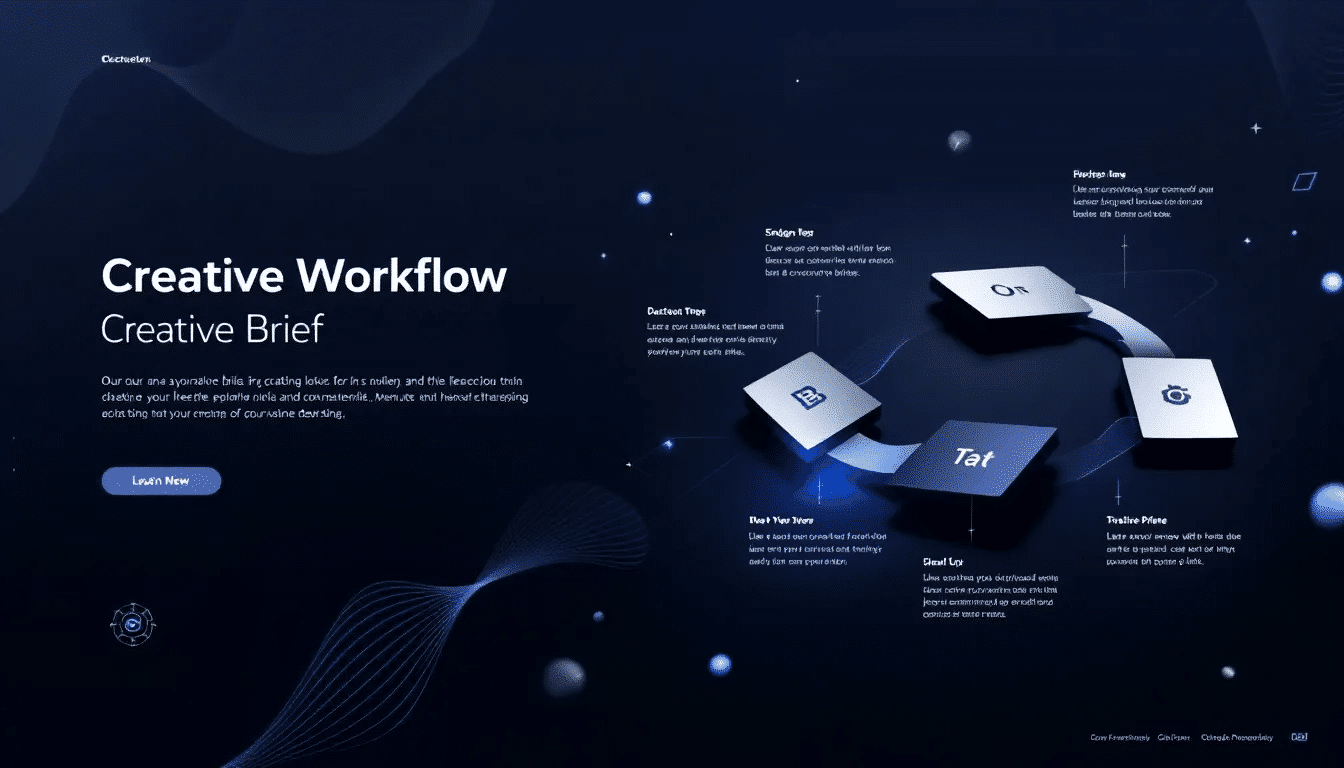Creating a Winning Creative Brief: Essential Steps and Free Templates

A creative brief is a document that outlines the key elements of a creative project. It provides direction, goals, and essential information like target audience, messaging, and deliverables. This keeps everyone on the same page and ensures the project’s success.
Creative briefs are especially important for organizing and streamlining an advertising campaign, making sure all marketing efforts are aligned with the project’s goals.
In this article, we’ll delve into the essential steps to creating a winning creative brief and offer free templates to get you started.
Introduction to Creative Briefs
A creative brief is the game-changing foundation of any successful creative project. Acting as your strategic roadmap, it delivers crystal-clear objectives, scope, and essential elements that empower your creative team to move seamlessly from initial concept to final completion. By defining your project’s purpose and deliverables with precision, a creative brief ensures that everyone involved in the creative process stays aligned, focused, and working toward one unified vision that drives results.
An effective creative brief doesn’t just set expectations—it transforms your team’s performance, sharpens focus like a laser, and provides an unshakeable reference point throughout your project’s entire lifecycle. Whether you’re launching a breakthrough campaign or developing fresh creative assets that captivate audiences, a well-structured brief streamlines collaboration, eliminates confusion, and drives exceptional creative outcomes that exceed expectations. Ultimately, creative briefs are powerful strategic tools that empower teams to deliver high-quality results, crush project objectives, and achieve lasting success that sets you apart from the competition.
Key Takeaways
- A creative brief is essential for aligning team members on project goals, minimizing miscommunication, and ensuring clarity throughout the creative process.
- Key components of an effective creative brief include project overview, audience insights, messaging, deliverables, timeline, and budget, which guide the creative team in producing relevant outputs.
- Utilizing a creative brief and regularly updating it throughout the project lifecycle fosters collaboration, enhances decision-making, and maintains alignment with client objectives, brand identity, and the client’s vision.
Understanding the Creative Brief

A creative brief is a fundamental guide for team collaboration, aligning creative requirements and messaging to ensure everyone is on the same page. The goal of a creative brief is to align team members on the project’s creative requirements and manage expectations, paving the way for successful execution. It serves as a roadmap that not only guides the project but also aligns the entire team’s vision. Imagine the brief as a compass that steers the creative process in the right direction, ensuring that all creative deliverables meet the project’s objectives.
The purpose of developing a creative brief is to facilitate the successful execution of creative work. It outlines the project’s goals, audience insights, messaging, and other critical elements, acting as a blueprint for the creative team. A well-defined brief ensures that all team members are working towards a common goal, minimizing the risk of miscommunication and misaligned expectations.
A creative brief should be treated as a dynamic document that evolves with project requirements. This adaptability helps the team respond to new insights or shifts in scope while maintaining focus on the main objectives. A well-structured creative brief also provides ongoing support for team collaboration, stakeholder alignment, and continuous feedback throughout the project.
Once the brief is created, a kickoff meeting is vital for launching to address any conflicts or restrictions, ensuring alignment and readiness to proceed.
At Ziflow, the creative briefing process is designed to be more organized and communicate progress effectively. By adopting a similar approach, you can transform your creativity in creative projects into well-oiled machines, ensuring clarity, direction, and successful new ideas.
Understanding the Competitive Landscape
A thorough understanding of the competitive landscape is your secret weapon for creative success. When you analyze the market and identify key competitors, you’re giving your team the valuable context that shapes powerful creative briefs and drives effective deliverables. You need to research what other brands are doing—examine their advertising campaigns, messaging, and market positioning—so you can spot trends, uncover gaps, and identify opportunities to set your brand apart from the crowd.
This process empowers you to craft a unique key message that truly resonates with your target audience and differentiates your brand in a crowded market. When you understand competitor strengths and weaknesses, you avoid common pitfalls and develop innovative ideas that capture attention. Incorporating insights from the competitive landscape into your creative brief ensures that every campaign is strategically positioned to achieve your project’s objectives and deliver maximum impact.
Ultimately, a well-researched competitive landscape gives you the power to create creative briefs that are not only relevant but also forward-thinking. You’ll help your brand stay ahead in the market and connect more effectively with your audience. This isn’t just research—it’s your competitive advantage.
Key Components of an Effective Creative Brief

A creative brief serves as a living document that provides direction for creative teams, outlining essential elements and project goals. Including the right components in a creative brief is crucial for effective project management and clarity among team members. These components ensure that the creative process is streamlined and that the final deliverables meet the project’s objectives.
The key components of an effective creative brief include key information on:
- Project Overview
- Project’s Purpose: Clearly stating the project’s purpose is essential, as it defines the fundamental goal and intention behind the project. This helps guide the creative process and ensures all stakeholders are aligned from the start.
- Audience Insights
- Messaging and Tone
- Deliverables and Specifications
- Timeline and Budget
Each of these important elements plays a vital role in guiding the creative team and ensuring that all aspects of the project are well-defined and aligned with the client’s vision and goals, providing inspiration for the team.
Project Overview
The project overview is the foundation of a creative brief, providing the creative team with a clear understanding of the project’s purpose. This section should detail the reasons for the client’s needs, the gaps the project aims to fill, and the problems it intends to solve. By offering a comprehensive summary, the project overview sets the stage for the entire creative process.
A well-crafted project overview includes the project’s purpose, background, and goals of the project. This high-level summary ensures that all team members have a shared understanding of the project’s objectives and the context in which they are working. It serves as a reference point that guides the creative team’s efforts and keeps them focused on the project’s ultimate goals.
Audience Insights
Defining the target audience is crucial for shaping creative deliverables that resonate with the intended audiences and the target market. This section should include demographic details such as:
- Age
- Gender
- Income level
- Marital status
- Education level
Understanding these demographics ensures that the creative work aligns with the audience’s characteristics and preferences.
In addition to demographics, incorporating psychographics and interests in the target audience description enhances the relevance of the creative work. Detailed insights into values, interests, and lifestyle choices help the creative team picture the ideal customer and create targeted messages that resonate with them.
Identifying the pain points of the target audience is essential for tailoring creative outputs that meet their specific needs. By understanding the challenges and obstacles the audience faces, the creative team can craft messages that address these pain points and enhance engagement. This deep understanding of the audience ensures that the creative work is not only compelling but also effective in achieving the project’s goals.
Messaging and Tone
Key messaging and tone are critical elements of a creative brief, guiding the overall communication strategy for the project. This section defines the desired language and emotional impact intended for the audience, ensuring clarity and consistency in communication. Establishing the right tone influences how the audience perceives the creative assets and their emotional response to the key message.
Without established brand guidelines, collaboration with team members is crucial to define the appropriate tone and voice for the project. This collaborative approach ensures that all stakeholders are on the same page and that the messaging aligns with the client’s vision and brand identity.
Brand Guidelines
Brand guidelines are your secret weapon for delivering consistency and cohesion across every creative asset you produce during your project. These guidelines serve as your comprehensive reference that empowers your creative team with crystal-clear direction on visual identity, tone of voice, and messaging standards that truly resonate. A robust brand guideline document gives you the competitive edge with detailed specifications for logos, color palettes, typography, imagery, and smart usage rules that work across all your media channels.
When you stick to these guidelines, your creative team becomes a powerhouse that ensures every single piece of creative work—whether it’s a social media post, advertisement, or website banner—perfectly reflects your brand’s identity and drives your objectives forward. Brand guidelines don’t just provide direction; they unlock new creative possibilities and make it incredibly easy for your whole team to stay aligned and deliver assets that amplify your brand’s message and maximize impact.
Effective brand guidelines don’t just streamline your creative process—they supercharge collaboration among your team members. With these clear standards in place, everyone involved in your project can confidently create and review creative assets, knowing they’re perfectly aligned with your brand’s vision and marketing goals. You get faster turnarounds, better results, and the peace of mind that comes from knowing your brand is always presented at its absolute best.
Deliverables and Specifications
The deliverables section of a creative brief specifies the concrete items required for project completion. This includes descriptions of assets, specific details, number of versions, and design elements. Providing detailed descriptions of deliverables ensures that there is no ambiguity and that the creative team has a clear understanding of what is expected. Clear deliverable descriptions also help guide the creatives responsible for developing the visual or conceptual assets, ensuring alignment with the brand and campaign goals.
Examples of deliverables might include three advertisements with different taglines and images, sized 250×250, 728×90, and 120×600.
The deliverables section should also specify technical details like file types and sizes to ensure that all creative assets meet the project’s requirements and standards.
Timeline and Budget
Establishing a project timeline involves:
- Setting important checkpoints for stakeholder involvement and feedback
- Defining a start date, end date, and important deadlines to ensure smooth progress and staying on track
- Remaining flexible to make adjustments as the work progresses
The budget section of a creative brief serves to prevent overspending on deliverables. Establishing a budget is important because it helps stay financially aligned and guides decision-making throughout the project. When writing down the budget, it’s crucial to include actual numbers and identified costs to maintain financial clarity.
Specifying both the overall budget and detailed cost allocations helps keep the project financially on track and ensures that resources are utilized effectively to achieve the project’s goals.
The Importance of a Well-Crafted Creative Brief

A creative brief is indispensable for aligning the team on deliverables, preventing assumptions, and avoiding distractions. By transforming ad-hoc project planning into a standardized process, a well-crafted creative brief significantly improves efficiency and clarity. Including complete information in the brief leads to fewer revisions later on, saving time and resources.
Documenting information in a creative brief ensures that all stakeholders can reference agreed-upon guidelines at any point during the project to write. This practice not only fosters transparency but also facilitates smoother collaboration and decision-making.
Enhancing Team Alignment
Creative briefs function as essential roadmaps that ensure all team members are focused on a shared objective. By aligning all stakeholders on the project’s aims and requirements, effective creative briefs enhance collaboration and prevent miscommunication. Think of the creative brief as a guiding star, providing clear instructions and maintaining alignment on project goals throughout the creative process.
A creative brief serves as a roadmap, guiding projects from inception to completion while ensuring clarity on scope and timelines. This clarity helps facilitate clear communication of the plan to stakeholders, reducing the risk of misunderstandings and ensuring that everyone is working towards the same objectives.
The use of a creative brief provides transparency to prevent miscommunication between team members. The person responsible for the creative brief must frequently review it to align outcomes with project objectives, ensuring that the project stays on track and meets its goals.
Streamlining Approvals
By specifying key stakeholders involved, a creative brief can simplify the approval steps in the project lifecycle and encourage buy in. This clarity ensures that everyone knows who needs to approve what and when, streamlining the decision-making process and minimizing delays.
Including expectations for feedback and a revision process in a creative brief helps streamline decision-making and minimizes back-and-forth. Defining specific business needs with measurable success criteria makes objectives clear, expediting the approval process and ensuring that all team members are aligned. The benefits include:
- Streamlined decision-making
- Minimized back-and-forth communication
- Clear objectives through measurable success criteria
- Expedited approval process
- Alignment of all team members
Improving Creative Quality
Creative briefs play a significant role in minimizing risks by identifying potential challenges early in the project. By providing a detailed framework, creative briefs encourage innovative good creative ideas that are aligned with both client expectations and market trends. This alignment ensures that the creative work produced is not only original but also effective in achieving the project’s objectives.
Brand consistency is maintained through creative briefs by ensuring that all outputs align with the established brand identity. This consistency is crucial for building a strong brand image and delivering a cohesive message across all marketing channels. Ultimately, creative briefs facilitate the alignment of creative outputs with client goals, leading to more effective marketing strategies and improved creative quality.
When to Use a Creative Brief

Creative briefs are essential for projects that are complex or require significant direction, such as comprehensive advertising campaigns. These documents provide the necessary structure to prevent ambiguity and ensure that all team members are aligned with the project’s goals and requirements. For non-standard and highly conceptual work, creative briefs are particularly useful in providing clear guidance and direction.
In collaborative efforts, creative briefs offer a framework that helps multiple stakeholders work towards a common goal. When working with external agencies, a well-defined brief minimizes miscommunication and ensures consistent messaging.
Whether the project is large or small, involving internal teams or external partners, a creative brief is a valuable tool for ensuring clarity, alignment, and successful outcomes.
Who Should Own the Creative Brief?
Clearly outlining stakeholders in a brief helps to establish roles and responsibilities, minimizing confusion during project development. The ownership of the creative brief typically varies based on project type, team size, and workflow. In many cases, the creative project manager or a designated team member takes on this responsibility, ensuring that the brief is frequently reviewed and updated as needed.
The person owning the creative brief should possess important skills, including knowledge about the client, organizational and leadership skills. This individual is responsible for consulting the brief often to ensure that deliverables align with guidelines and goals, ultimately contributing to the project’s success as a product manager.
Step-by-Step Guide to Writing a Creative Brief
A well-structured creative brief enhances project organization, ensuring that all team members maintain focus on objectives. Even simple tasks like edits or revisions should have a brief to ensure clarity and prevent confusion. Creative briefs are invaluable for ongoing brand or project efforts, keeping everyone aligned with long-term vision and goals.
When collaborating with an agency, it is crucial to share a comprehensive creative brief that clearly outlines the agency’s role, responsibilities, and input in the project workflow. This ensures smooth execution and alignment between all parties involved.
A quality creative brief addresses key questions like the problem at hand, the target audience affected, and the desired outcomes from engagement. Templates commonly feature sections like project overview, audience, and deliverables to clearly outline the project’s scope and target.
Templates can vary by industry, with specific adaptations for marketing, design, and video production projects.
Summarize the Project
The first step in writing a creative brief is to summarize the project, providing clarity for the team. A project summary entails a high-level overview expressed in a couple of sentences. This summary sets the context for the creative team’s work and ensures that all team members have a shared understanding of the project’s objectives.
Including a project summary in the creative brief sets the context for subsequent details in the brief. This high-level overview ensures that all team members are on the same page and that the creative process starts with a clear direction.
Define Objectives and Goals
A creative brief outlines a project’s goals and scope, serving as a framework for idea exploration. Detailed descriptions of these goals provide clear focus and align the team’s efforts with the client’s vision.
Objectives should include specific business needs and measurable criteria to evaluate the project’s success. A well-crafted creative brief aligns deliverables with the client’s goals and inspires creative development, ensuring that the final outputs meet the project objective and achieve the desired outcomes.
Identify the Target Audience
Identifying the demographics of the target audience is crucial for establishing who they are and ensuring that the creative work resonates with them. This includes details such as:
- Age
- Gender
- Income level
- Education
Understanding the interests of the target audience, such as hobbies, preferences, and lifestyle choices, allows the creative team to engage them effectively in this world.
Understanding the pain points of the target audience aids in crafting messages that address their challenges and enhance engagement. Aligning creative work with the audience’s expectations ensures compelling and relevant outcomes.
Specify Deliverables and Formats
Clearly outlining deliverables is essential to prevent confusion and maintain clarity throughout the project. It’s crucial to list all expected deliverables in detail to avoid any ambiguity as the project progresses. This includes specifying formats, sizes, and any essential details necessary for the creative assets.
Detailed descriptions of deliverables ensure that all creative assets meet project requirements and standards. This clarity prevents misunderstandings and aligns final outputs with project objectives.
Set a Timeline and Budget
Establishing a timeline involves:
- Specifying key dates, including the project start date, final deadline, and any significant milestones.
- Setting deadlines for each phase of the project.
- Defining a budget for the creative tasks while creating a structured approach.
This timeline helps ensure that the project progresses smoothly and stays on track. Setting deadlines and a budget is crucial for effective project management and execution.
A defined budget helps manage resources effectively, aligning them with project goals. Clear timelines and budget parameters guide planning, ensuring efficient resource use and financial alignment.
Using Creative Brief Templates
Creative brief templates are game-changing resources for any creative team ready to launch projects with crystal-clear direction and unshakeable confidence. These powerhouse documents deliver a structured framework that captures every critical element needed for creative success—from razor-sharp project objectives and scope to precise deliverables and rock-solid timelines. By leveraging a creative brief template, you guarantee that zero important details slip through the cracks and that your team operates with complete alignment on expectations from day one.
Fully customizable to match the unique demands of any project, creative brief templates slash time and effort, empowering your team to focus on what matters most—generating breakthrough creative ideas and executing high-impact creative work. The market offers abundant free creative brief templates from industry-leading platforms like Asana, HubSpot, and Ziflow. These premium free creative resources provide the perfect foundation, making it effortless to consolidate all essential information and keep your project locked on target. With the right template in your arsenal, your team can rapidly align on objectives, crystallize the project’s scope, and set the stage for creative excellence.
Streamlining Creative Projects
A well-crafted creative brief is the game-changing solution that transforms your creative projects and supercharges your team’s performance. By delivering crystal-clear direction and unified focus, a creative brief template ensures every team member is perfectly aligned with project goals and fully understands their critical role in the creative process. This powerful alignment eliminates misunderstandings and miscommunications, keeping everyone moving in perfect sync toward success.
Leveraging a creative brief empowers you to spot potential challenges and roadblocks before they strike, so your team can proactively develop winning solutions and avoid costly project delays. With a comprehensive brief as your foundation, your creative team doesn’t just work efficiently—they stay laser-focused on objectives and consistently deliver exceptional creative results on schedule. A creative brief template doesn’t just simplify planning and execution—it transforms your team into a high-performance creative powerhouse that consistently produces premium-quality work that exceeds client expectations every single time.
Distribution and Approval
The distribution and approval phase is where creative ideas transform into powerful results and connect with your intended target audience. A well-structured distribution plan, detailed in the creative brief example, maps out the channels, formats, and timelines for delivering creative assets that drive impact. This strategic approach ensures that the right content reaches the right audience at the right time, maximizing the return on your creative investment.
Equally critical is a clearly defined approval process that eliminates bottlenecks and accelerates success. By identifying which stakeholders and clients hold responsibility for reviewing and approving each deliverable, and establishing clear criteria and deadlines, your team can bypass unnecessary delays and costly revisions. This structured methodology streamlines the launch process, ensuring that all creative assets exceed expected standards and deliver on project objectives.
Including a detailed distribution and approval plan in the creative brief empowers your team to stay organized, deliver on schedule, and achieve a successful project launch that satisfies both client expectations and target audience needs. With this approach, you don’t just manage projects—you drive results that matter.
Example Creative Brief Template
Three customizable templates for creative briefs are available, designed to cater to campaign needs, including standard, video, and client-specific briefs. These free creative brief templates provide a structured format that helps streamline the creative process and ensure all essential elements are included, making it a free creative resource for users.
Many agencies utilize customizable request forms that automatically convert client responses into structured creative briefs. This automation saves time and ensures that all necessary information is captured accurately. A well-designed creative brief template should remain concise, ideally spanning 1-2 pages, for easy reference and adaptability.
An example creative brief template might include sections such as:
- Project Overview
- Audience Insights
- Messaging and Tone
- Deliverables and Specifications
- Timeline and Budget
By using these templates, creative teams can ensure that all the necessary information is documented and that the project starts on the right foot. Customizable templates also allow for flexibility and can be adapted to different types of creative projects.
Case Studies and Success Stories
Case studies and success stories are game-changing tools that will supercharge your creative team’s inspiration and drive continuous improvement. By diving into real-world examples of winning creative projects, you can unlock proven strategies, breakthrough creative ideas, and battle-tested best practices that you’ll apply directly to your future work. These case studies give you the complete picture—project objectives, target audience, creative brief, execution, and measurable outcomes—delivering the insider insights you need to understand what truly drives effective creative.
You’ll spark fresh ideas and refine your creative process when you share these powerful stories within your team, ultimately improving the quality of your creative briefs. Free creative brief templates and examples, crafted from successful campaigns, give you a practical starting point that sets your new projects up for success—ensuring you’re equipped with all the essential information to create work that makes a real impact.
You’ll stay inspired, keep your projects on track, and consistently deliver creative work that not only meets objectives but exceeds stakeholder expectations when you learn from past victories and analyze what delivered results. This approach transforms your team into a powerhouse that builds on proven success.
How to Use Your Creative Brief Effectively

Utilizing a creative brief as a guiding document can enhance team focus and ensure everyone is aligned on objectives. Engaging in discussions about the creative brief with the team can clarify expectations and foster collaboration. These discussions ensure that all team members understand their roles and responsibilities and that any potential issues are addressed early on.
Using project management tools can streamline the integration and application of the creative brief throughout the project. These tools help track progress, manage timelines, and ensure that all deliverables are completed on time and within budget. Regularly updating the creative brief helps accommodate any changes in project scope or direction, ensuring that the project stays on track and meets its goals.
Summary
In summary, a well-crafted creative brief is an indispensable tool for any creative project. It ensures that all team members are aligned, expectations are managed, and the final deliverables meet the project’s objectives. By including essential components such as project overview, audience insights, messaging and tone, deliverables and specifications, and timeline and budget, creative briefs provide a clear and structured framework for the creative process.
Implementing the strategies discussed in this guide will help you create effective creative briefs that enhance team collaboration, streamline approvals, and improve the quality of your creative work. Remember, a creative brief is a living document that should evolve as the project progresses, ensuring that your creative team remains focused and aligned with the project’s goals. Embrace the power of a well-crafted creative brief and unlock the full potential of your creative projects.
Frequently Asked Questions
How to create an ad brief?
To create an effective ad brief, start by summarising the project and setting clear objectives. Define your target audience, outline your key messages, and ensure brand guidelines are included. You should also list the required deliverables and formats, set a realistic timeline and budget, and establish success metrics alongside an approval process.
How InvestGlass helps: With InvestGlass, you can centralise all this information in one place, making it easy for teams to collaborate, track progress, and keep every step aligned with your objectives.
What is the purpose of a creative brief?
A creative brief aligns all team members on project requirements and helps manage expectations, ensuring that creative work is delivered effectively and consistently.
How InvestGlass helps: InvestGlass provides a structured workflow for briefing, ensuring everyone has visibility of goals, tasks, and deadlines—reducing miscommunication and streamlining delivery.
What are the key components of an effective creative brief?
An effective creative brief should include:
- A project overview
- Audience insights
- Messaging and tone of voice
- Deliverables and specifications
- Timeline and budget
Having these elements clearly defined sets the foundation for a successful creative process.
How InvestGlass helps: By using InvestGlass templates, you can standardise briefs, ensuring consistency across campaigns while still allowing flexibility to customise according to each project.
Who should own the creative brief?
Ownership of the creative brief usually falls to the creative project manager or a designated team member with strong organisational and leadership skills. This ensures direction, clarity, and accountability throughout the project.
How InvestGlass helps: InvestGlass assigns clear ownership and accountability within the platform, so everyone knows who is responsible for each stage of the project.
Stakeholders and Communication
Strong stakeholder communication is the foundation of successful creative projects. The creative project manager acts as the central orchestrator, aligning clients, account managers, and internal teams with project objectives, timelines, and budgets.
Establishing effective communication channels from the outset prevents misunderstandings and keeps momentum alive. Regular updates, dynamic progress reports, and open lines of communication foster trust, accelerate feedback, and empower teams to achieve results quickly and precisely.
How InvestGlass helps: With InvestGlass, you can manage stakeholder communication in real time, share progress updates, and integrate client feedback seamlessly. This builds trust and ensures final deliverables exceed expectations while keeping resources optimised and budgets protected.
When should a creative brief be used?
A creative brief is essential for:
- Complex projects
- Highly conceptual work
- Collaborative efforts
- Projects involving external agencies
It ensures clarity and alignment among all stakeholders from the outset.
How InvestGlass helps: InvestGlass ensures every project—whether internal or with partners—benefits from a clear, accessible, and well-structured brief, improving efficiency and outcomes.